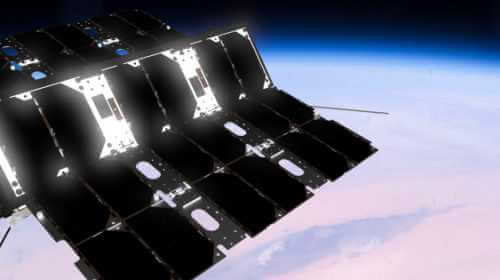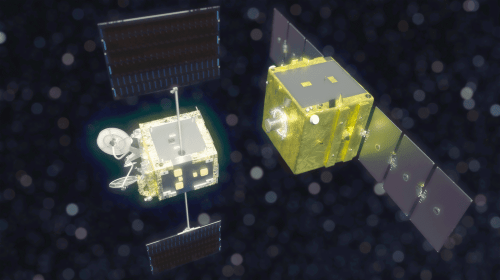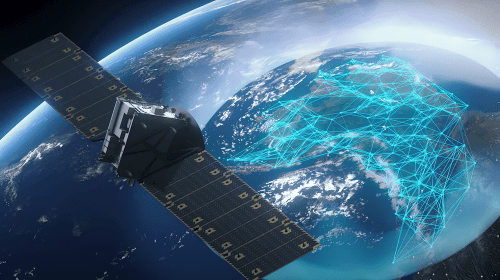Mx-DMA MRC – What is it?
Dec 23, 2021
BusinessCom Networks has been offering ST Engineering iDirect’s MF-TDMA platform for many years, with hundreds of sites deployed. We have also delivered large, dedicated circuits based on Newtec’s DVB-S2X leveraging BWC (bandwidth cancelation) efficiencies. iDirect and Newtec are now part of the same company, and we have recently added services on the Newtec Dialog platform, initially for very competitively priced dedicated circuits. This platform is based on the industry’s most efficient, dynamic return (upload) technology – Mx-DMA MRC (Cross Dimensional Multiple Access technology with Multi-Resolution Coding). The technology is a variation of MF-TDMA (Multi Frequency – Time Division Multiple Access) which was enhanced and popularized by sister company iDirect in the late 1990’s and early 2000’s.
Forward Link
The forward link (outbound or download to the remote sites) may be defined at the hub as DVB-S2X, or DVB-S2X Annex M (wideband). Annex M leverages the use of virtual carriers to provide multiple (virtual) forward carriers within a single physical carrier. This forward link technology which is not unique to Newtec is a way to leverage the wide transponders available on HTS (High Transport Satellites) that can reach throughputs of ~2 Gbps. Creating multiple, smaller virtual carriers, provides a way to reduce the complexity and cost of the expensive equipment required to receive wideband carriers.
In this article we will primarily be reviewing the Return Link.
Return Link
The Dialog platform offers SCPC, MF-TDMA and Mx-DMA return options. This discussion centers around the Mx-DMA return link option.
Like MF-TDMA there are still time slots and frequencies allocated to multiple remote terminals. Similarly, there are multiple inroute (upload) carriers at different frequencies. Each carrier has multiple time slots, just as in MF-TDMA. Terminals are assigned to time slots using varying symbol rates (bandwidth) and FEC (forward error correction) rates.

A key differentiator is that Mx-DMA allows terminals to transmit continuously with reduced energy even if they have no data to transmit. This reduces the amount of bandwidth wasted to synchronize the receiver and the transmitter. With normal MF-TDMA, the network needs to allocate guard time between slots. This is analogous to guard bands used to separate carriers, but this is a “guard” in time. The guard time is normally required as there are inaccuracies in transmission timings between the remote sites, and the addition of guard time prevents them from stepping on each other’s transmissions, and creating collisions, and thus a need to retransmit. In addition to the guard time, there is wasted overhead in the form of non-payload data such as a long preamble in every transmitted burst. It is important because if a remote can’t hit its time slot perfectly, transmissions may overlap, which will result in further wasted bandwidth. This is in addition to collisions where remotes can attempt to occupy a single time slot. Newtec’s technology allows the system to effectively get rid of that guard time, as remotes are steered across time slots by the hub continuously. They always remain in sync and the hub never loses the “lock” on a remote, even if it has nothing to transmit.
In normal MF-TDMA the remote must re-acquire the terminal signal each time the signal moves to a new frequency carrier and/or symbol rate. This adds a significant amount of data, such as a long preamble used for synchronization purposes. With Mx-DMA, there is no need for re-acquisition as the remotes transmit continuously. Remotes can occupy a particular carrier frequency, symbol rate and code rate, effectively “carving” out what we may refer to as a “virtual carrier” inside an Mx-DMA carrier. It is still time-divided, but a remote here can occupy a static pattern of time slots on a fixed inroute frequency, with a static code rate, until the remote’s bandwidth requirements dictate that it needs more or less bandwidth. Presumably when a remote has a buffer build-up, this is communicated to the hub, which would then allocate another “virtual carrier” for the remote, by carving out a series of longer duration time slots.
A significant advantage occurs because the remote can occupy a series of time slots and is not confined to short time slots as with conventional MF-TDMA. As a result, it can use longer FEC code words which raises spectral efficiency by sacrificing a small amount of latency.
The hub and remotes communicate with each other, allowing the hub to notify the remote of any signal distortion coming back from transmitting remotes. The hub can therefore allow a remote BUC to operate at maximum saturation, maximizing power output. To summarize; with conventional MF-TDMA we have fixed time slots and guard time between the slots. Some portion of inroute carrier must be wasted to compensate for remotes not hitting their slots perfectly in time. With Mx-DMA, the hub steers remotes across slots of varying duration. These “virtual” carriers are predetermined patterns of time slots, which makes it possible to eliminate guard bands and guard times, maximizing efficiency.
Mx-DMA HRC
The first implementation of Mx-DMA leveraged HRC or High Resolution Coding, a return technology that makes real time adjustments to the frequency plan, symbol rate, modulation, coding, and power in real time for all terminals in the satellite network. Based on return traffic demand, QoS (Quality of Service) management, and channel conditions, adjustments are continually made for all terminals in the network.
As discussed above, within the Mx-DMA HRC return link, a “virtual” carrier is assigned to each terminal, allowing it to achieve SCPC-like efficiency on the return path, while maintaining MF-TDMA flexibility. In real time, based on demand from terminals and QoS profiles, bandwidth is allocated on the fly. When traffic from a particular terminal becomes more important, extra bandwidth is assigned to its “virtual” carrier. This all happens seamlessly, with no loss of data packets.
The HRC implementation is well suited for low-to-high data rate applications ranging from 32 kbps to 200 Mbps. The level of efficiency can be compared with DVB-S2 with a 5% roll-off factor, working to get as many bits through the available bandwidth as possible. Using short block codes, HRC optimizes low-to-medium rate traffic and minimizes latency over satellite.

Mx-DMA MRC
MRC (Multi-Resolution Coding) adds to the scalability of MF-TDMA and SCPC-like efficiency with service agility, efficiency, and flexibility, providing support for very large networks, and supporting a wide range of applications. It is agile and granular in managing the MODCOD (modulation and coding), symbol rate, frequency, transmission duration and code block size. For example, Mx-DMA MRC increases bandwidth allocation granularity by a factor of 25. This gives the system the ability to support a wide mix of applications using shared return capacity.
Precise knowledge of traffic and terminal mix is not required, as the link self-optimizes in real time. Operators are not forced into making cumbersome trade-offs by predefining return carriers to support a mix of terminal and service types. Instead Mx-DMA MRC orchestrates the allocation of available capacity automatically. The high efficiency equates to bandwidth savings, increased throughput, and network availability, and can lead to substantial cost savings for terminals.
Different types of terminals across 512 carriers transmit traffic every 5 msec, within a 40 msec frame. With each 40 msec frame, the terminals fill up different carriers based on individual traffic profiles. If a terminal has a mostly static traffic profile, it will transmit continuously like an SCPC link. Bursty terminals will transmit different bursts into different frames, while terminals with sporadic traffic, will transmit only into a subset of frames. Finally, terminals that are not transmitting for a programmable amount of time are logged off so there is no wasted consumption of the space segment. Up to 5000 active terminals may be supported on a single multi-carrier hub demodulator, which significantly increases hub density, and reduces hub, rack, and power requirements.
BusinessCom is now actively quoting and has recently deployed and activated services based on the Dialog platform. Currently we are delivering dedicated circuits, however we do have plans to support shared remotes, bundled with our SecureLink threat management support, as we increase our comfort with the platform. In the meantime, we are quoting dedicated circuits at good prices on a variety of satellites around the world, using the MDM 2510, MDM3310 and MDM 5010 modems based on which is best for the application.






